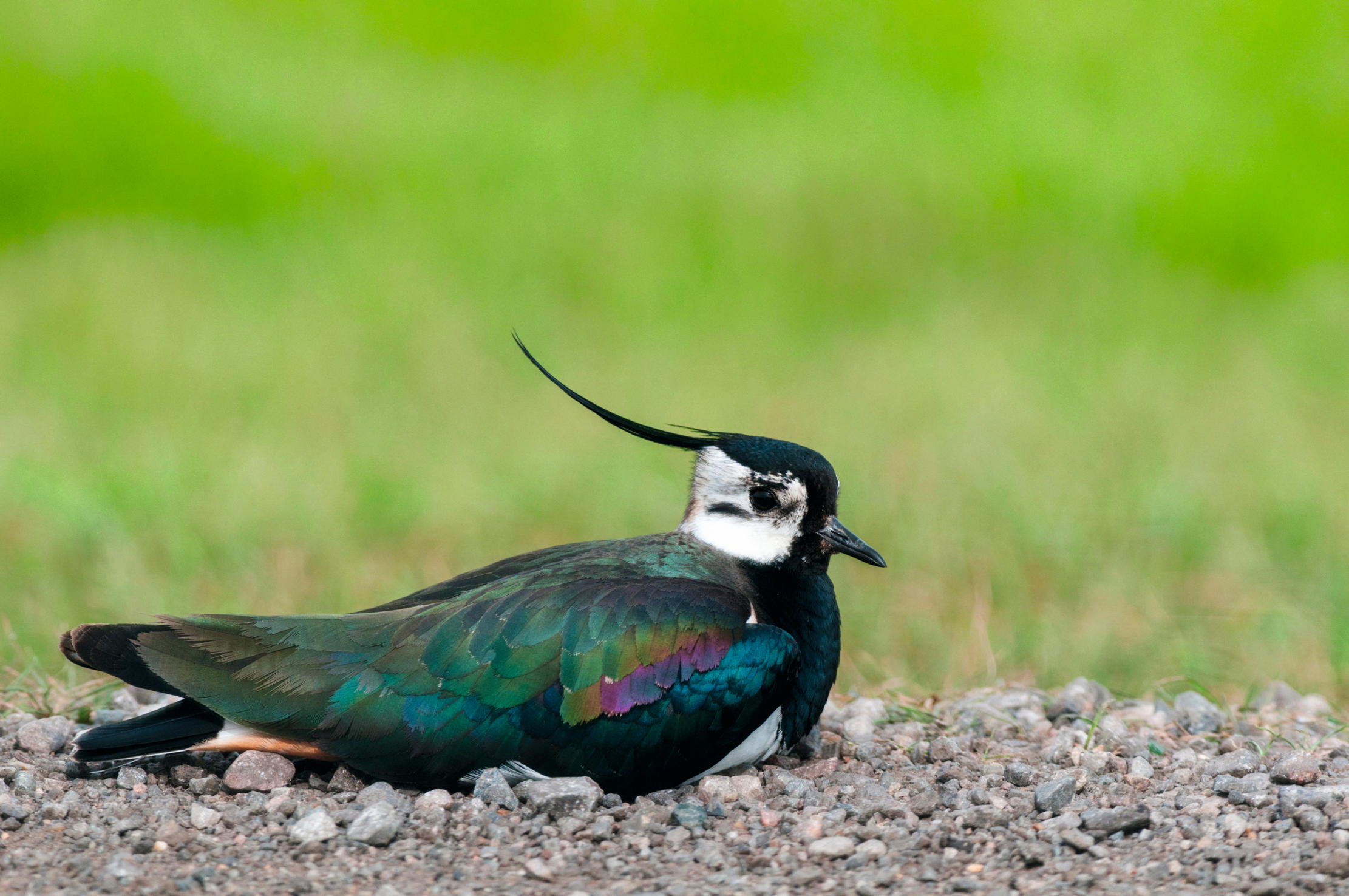The Lapwing, the bird with dozens names that is 'one of the most evocative sights and sounds of the countryside'
Often preceded by its otherworldly call, the jaunty emerald-and-purple lapwing is an increasingly rare presence in southern England, says Vicky Liddell, as she explores a new initiative to halt the decline.


The sparkling pied plumage and plaintive two-note call of a northern lapwing are some of the most evocative sights and sounds of the countryside. In spring, male birds tumble acrobatically through the sky, rolling and diving to attract potential mates; on the ground, their long pink legs, iridescent emerald and purple feathers and jaunty crests bring a touch of style to farmland. In winter, when both sexes join up with larger flocks of Continental birds, their numbers mask the sad fact that populations of native lapwing (Vanellus vanellus) have plummeted by 60% in the past 25 years and the bird is now red listed by the RSPB.
The lapwing is a member of the Charadriiformes order and, despite recent declines, it’s still the UK’s most common breeding wader. Often heard before it’s seen, its scientific name Vanellus derives from the Latin for little winnowing fan, which is thought to be a reference to the flapping sound the birds’ wings make in flight. Their common name, lapwing, refers to the slow, undulating wing beat that makes them appear to almost hang in the sky. Yet its most distinctive characteristic is the strange, otherworldly call that has earned this enchanting wader a long list of region-specific nicknames, from the oft- used ‘peewit’ to ‘chewits’ in Lancashire, ‘pie-wipes’ in Norfolk, ‘lappy’ in Yorkshire and, in parts of Scotland, ‘peasiewheeps’.
The decline in lapwings was initially caused by the Victorian craze for ‘egging’. In the late 19th century, lapwing eggs were collected from Norfolk marshland at a rate of 600–700 a week, then taken to London, where they were placed in baskets lined with moss and sold at three shillings a dozen. The eggs were considered a great delicacy and were famously served by Sebastian Flyte in Evelyn Waugh’s Brideshead Revisited (‘Mummy sends them from Brideshead. They always lay early for her’).
Gradually, as the countryside was stripped, eggs had to be imported from Holland to fill the gap, until the 1926 Lapwing Act finally put an end to the practice. For a while, the fortunes of the lapwing seemed to improve. However, from the 1940s, changes in agricultural practices and the conversion of grassland to arable caused further decline and, according to the latest figures from the RSPB, the current breeding population is down to only 97,500 pairs.

Over the past decade, various lapwing initiatives have been launched in an attempt to help maintain suitable nesting habitat by encouraging farmers to plant a variety of spring-grown crops, maintain damp areas and manage grazing. This year, Project Peewit, a joint scheme by the Wiltshire & Swindon Biological Records Centre (WSBRC) and the Wiltshire Wildlife Trust, will try to locate the sites where lapwing remain and identify the problems they face.
‘The lapwing is deeply ingrained within Wiltshire landscapes and understanding their current status and distribution and working alongside landowners is crucial to help us conserve and protect this precious bird,’ explains Jonny Cooper, biological research officer at WSBRC. ‘One of the most important things they need is rough ground with a plentiful supply of invertebrates. Lapwings are dedicated parents — if there is not enough to eat, the adults will lead their young miles, sometimes even over A roads, in search of food.’
Breeding begins in March, after the male bird has performed his magnificent display and created several small scrapes on the ground for inspection by prospective females. Once she has selected a suitable scrape, she will line it carefully with a layer of reed grass and lay one egg a day until four speckled, olive-coloured eggs are ready to begin the 25-day incubation. Lapwing like to nest in open areas where they can enjoy a 360-degree view of potential predators. Indeed, these plucky birds need nerves of steel to protect their exposed young from foxes, buzzards and crows, with many pairs choosing to nest in small groups, thereby allowing them to mount a cooperative defence. If a predator spots a nest, the parents will fly directly at the intruder or create a distraction by moving away and dragging a wing to draw attention to themselves. They also make visits to false nest sites in order to deter would-be marauders, a ‘deceptive’ behaviour that’s thought to have given rise to their collective noun, deceit.
Sign up for the Country Life Newsletter
Exquisite houses, the beauty of Nature, and how to get the most from your life, straight to your inbox.
Although the noble lapwing seems undeserving of its ‘deceitful’ reputation, its history of disgrace goes back a long way. In 1381, in The Parliament of Fowles, Chaucer described the lapwing as the ‘false lapwynge, full of treacherye’ and in Shakespeare’s The Comedy of Errors, the playwright includes a reference to the lapwing’s distraction display when Adriana says ‘far from her nest the lapwing cries away’. In folklore, the peewit call was associated with the seven whistlers (seven birds flying together by night, the cries of which foretold disaster) and another old legend believed that each lapwing embodies the spirits of people who still haunt the earth. In the 17th century, betrayal was added to the lapwing’s list of ‘crimes’ when it was blamed by the Protestant Covenanters of Scotland for giving away their moorland hiding place with its call.
Distribution of the lapwing varies considerably throughout the UK. In Scotland, where there has been a decline of 29% since 1987, they are faring slightly better, with good densities of breeding birds in Orkney, Shetland and the Outer Hebrides. They are also breeding well on the grouse moors of Aberdeenshire, Angus and Perthshire. Further south, on nature reserves and other sites managed for wildlife, there is more positive news. In 2023, an impressive 25 lapwing chicks hatched at Testwood Lakes Nature Reserve in Hampshire. ‘Unfortunately, this year is not so promising,’ laments Ben Pickup, reserves officer. ‘Early nests were flooded when the River Blackwater rose, but all is not lost. The birds have started again and we have six pairs sitting on eggs.’
Outside the breeding season, lapwings resume their sociable and gregarious lifestyle, wheeling around in enormous flocks. From September, migrating lapwing arrive from Scandinavia and northern Europe and the overwintering population quadruples to an estimated 635,000 birds. Many of the lapwing in southern Britain stay local, although others migrate short distances. Ireland is a popular choice, as it has slightly milder winters; other birds choose France and the Iberian Peninsula.
Once so numerous that they were known as the farmer’s friend thanks to their pestguzzling prowess, the lapwing has struggled to adapt to modern farming. ‘It’s often only when people are asked whether they have seen them that they realise they haven’t,’ reflects Mr Cooper. ‘The first year of Project Peewit will be a fact-finding mission to get a rough population estimate. Then, we can help landowners encourage lapwings and, at the same time, encourage other endangered species, such as the skylark.’ One day, that haunting call may once again be heard across the land.
For more information about Project Peewit, visit www.wsbrc.org/projects/project-peewit
The Lapwing: bird of many names
- Lapwing have become interwoven with place names across the country, such as Pyewipe near Grimsby, Lincolnshire, Tewitfield near Lancaster in Lancashire, and Tivetshall St Mary in Norfolk
- Each female fledges one brood a year, but can lay up to five replacement clutches if eggs are lost. After five to six weeks, the young are ready to fly
- The black-headed gull and the lapwing have a strange love/hate relationship. The lapwing tolerates food thieving from the gull in return for some protection
- The birds may be seen tapping the ground to encourage earthworms, but they will also eat ants, beetles and caterpillars, as well as snails and small frogs
- A lapwing’s favourite breeding place is in the Netherlands, where some 200,000–300,000 enjoy the rich mixture of grassland and wetland
- Both sexes have splendid crests, although the male’s is longer and becomes even more showy in the breeding season
Vicky Liddell is a nature and countryside journalist from Hampshire who also runs a herb nursery.
-
 In all its glory: One of Britain’s most striking moth species could be making a comeback
In all its glory: One of Britain’s most striking moth species could be making a comebackThe Kentish glory moth has been absent from England and Wales for around 50 years.
By Jack Watkins
-
 Could Gruber's Antiques from Paddington 2 be your new Notting Hill home?
Could Gruber's Antiques from Paddington 2 be your new Notting Hill home?It was the home of Mr Gruber and his antiques in the film, but in the real world, Alice's Antiques could be yours.
By James Fisher